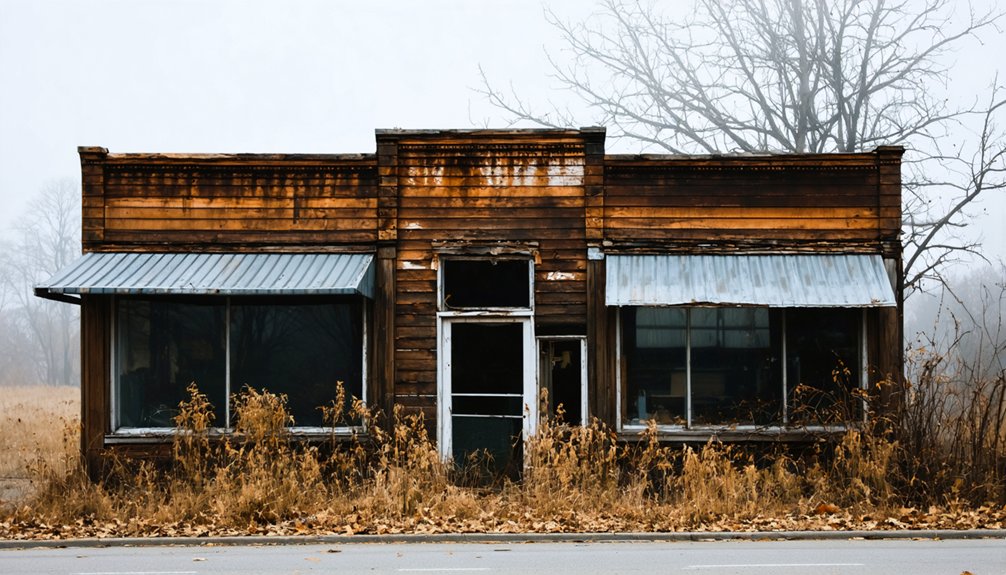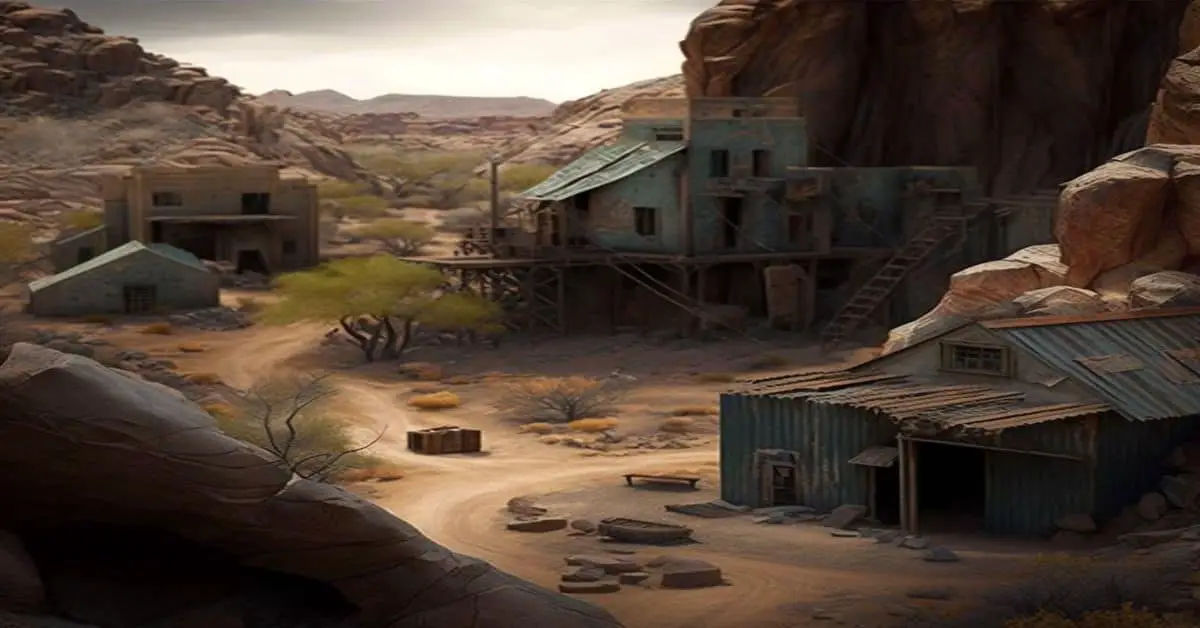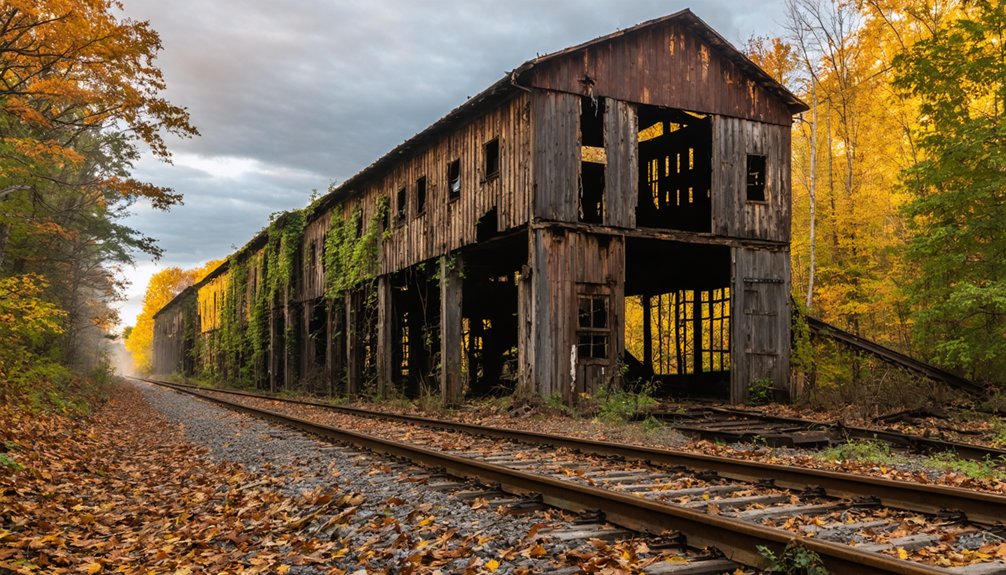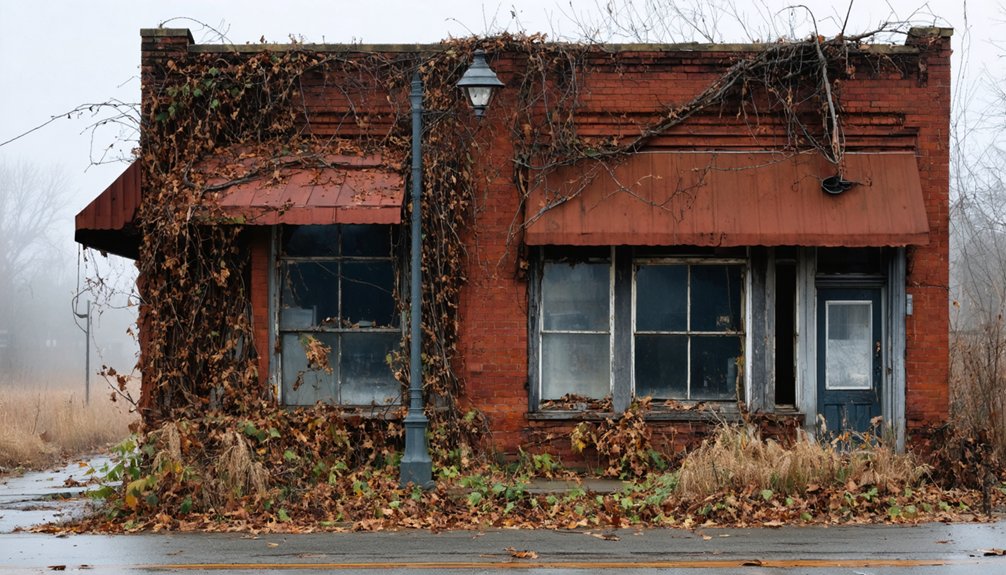You’ll find Toronto’s ghost town ruins along an abandoned Baltimore and Ohio Railroad line in Indiana. Originally named Bono in 1817, this once-bustling farming community changed its name to Toronto and thrived with mills, shops, and a vibrant social scene centered around its general store and tavern. When Charles Dana’s railroad bypassed the town, Toronto’s fate was sealed. Today, weathered buildings and overgrown paths whisper stories of a forgotten era waiting to be discovered.
Key Takeaways
- Toronto, Indiana was originally named Bono and served as a thriving settlement along the White River in the early 1800s.
- The town’s decline began when Charles Dana’s railroad bypassed the settlement, significantly reducing its economic importance.
- Once featuring mills, workshops, and a bustling general store, Toronto now stands largely abandoned as a ghost town.
- The Ruthven Mill served as the town’s industrial anchor before economic activities ceased and residents gradually left.
- Preservation groups like Indiana Landmarks and Decay Devils are working to document and restore Toronto’s remaining historical structures.
The Birth of Bono: Early Settlement Years
As pioneers ventured into the untamed wilderness of early 1800s Indiana, they discovered a promising stretch of land that would soon become Bono. You’d have found these early settlers drawn to the area’s abundant waterways and rich soil – their primary motivations for establishing roots in this fertile region.
Much like other French pioneers who established settlements across North America, these determined individuals carved out a new life in the wilderness. If you’d walked these lands back then, you’d have seen European-American families building modest cabins and breaking ground for their first crops. The demographic changes happened gradually as news spread of the area’s potential. Similar to the initial growth of nearby Tunnelton, which was platted in 1859, the settlement began to take shape.
You would’ve witnessed neighbors helping neighbors raise barns, share harvests, and create makeshift gathering places for worship and community meetings. Together, they transformed virgin forest into productive farmland, marking their territory with newly surveyed plots and primitive roads that would serve as lifelines to the outside world.
From Bono to Toronto: The Name Change Story
You’ll find the story of Bono’s transformation into Toronto written in the weathered headstones of the local cemetery, where both names stand as silent witnesses to this historical change.
Records show the settlement originally called Bono gradually adopted the name Toronto, though the exact timing and reasoning behind this switch remains shrouded in mystery.
The cemetery contains 1,778 total memorials that help document the area’s rich history.
While you might wonder about the connection to Canada’s largest city, this Indiana town’s adoption of the name Toronto appears to be entirely separate from its more famous namesake.
Much like the musician Bono’s commitment to fighting poverty and hunger, this small town bearing his namesake left its own legacy of community support.
Early Bono Settlement Origins
Back in 1816, when Indiana was still finding its footing as a new state, a small settlement emerged along the White River that would become known as Bono. You can trace the footsteps of early settlers like the Flinn and Guthrie families, who braved the wilderness to establish the first blockhouse in 1810. In 1817, Bono was chartered as Orange County’s township before becoming part of Lawrence County. Like the famous Irish singer who would later share its name, the town had humble beginnings before making its mark.
The rich Bono history includes these fascinating details:
- Named after Pierre Bono, a patriot mail carrier from Vincennes
- Once considered as Indiana’s potential state capital
- First recorded settlement in Lawrence County
- Early landowners included Moses Blunk and Andrew Pickett
- Established at 659 feet elevation near crucial White River trading routes
Those pioneer families faced constant challenges from Native American tribes, but their determination laid the foundation for what would become Lawrence County’s oldest settlement.
Name Transition to Toronto
The transformation of Bono into Toronto stands as one of Indiana’s most intriguing name-change stories from the 19th century.
While you won’t find official documents detailing the exact moment of change, you’ll discover clues in places like the local cemetery, which carries both names – an indication of the community’s evolving identity.
The name significance runs deeper than mere words on a map. Similar to how the city of Toronto in Canada changed its name in March 6, 1834, small towns across North America underwent their own identity transformations.
Like many 19th-century American towns, the shift from Bono (meaning “good”) to Toronto likely reflected the community’s desire to forge a distinct identity.
You’ll notice this pattern in the way local infrastructure gradually adopted the new name, though some landmarks, like the famous Bono Rock, stubbornly held onto their original titles, preserving a slice of the town’s heritage.
Daily Life in 19th Century Toronto
You’d find the heart of Toronto’s social life at community gatherings, where neighbors celebrated harvests and seasonal milestones with fairs that strengthened their bonds.
Your daily routine would’ve revolved around essential tasks like tending to kitchen gardens, caring for livestock, and preserving food for the harsh Indiana winters.
Walking down Toronto’s main street, you’d encounter the general store bustling with activity as local farmers traded crops for supplies and sought credit from merchants until their next harvest.
The Mississauga population faced severe decline from disease and displacement, dropping from 500 to less than 200 residents in just forty years.
Indigenous families often undertook seasonal work patterns, moving between urban areas and traditional territories to sustain their livelihoods.
Community Gatherings and Events
During Toronto’s heyday in nineteenth-century Indiana, vibrant community gatherings centered around Frederick Sholts’s popular tavern and hotel, where locals and weary travelers would mingle over hearty meals and lively conversation.
You’d find yourself swept up in the town’s rich tapestry of cultural gatherings and social events that brought everyone together, from high-society affairs to simple neighborhood meetups. The discovery of Thompson papers and ledgers has provided fascinating details about these social interactions.
- Independence Day celebrations filled the streets with patriotic spirit
- Evening storytelling and music sessions at the tavern warmed winter nights
- Sunday services and religious observances strengthened spiritual bonds
- Seasonal markets and trading days bustled with commerce and conversation
- Community picnics and cultural performances showcased local talent
Life in Toronto wasn’t just about survival – it was about creating meaningful connections through shared experiences and traditions.
Household Daily Routines
Life in nineteenth-century Toronto revolved around strict daily routines that shaped every household’s rhythm and purpose. You’d wake before dawn to tend to essential household chores, with women managing the hearth while men headed to fields or workshops.
Children would help with daily tasks, learning valuable skills that would serve them later in life.
Meal preparation dominated your day’s schedule. You’d spend hours tending to the fire, cooking hearty breakfasts and preparing substantial dinners from basic ingredients like potatoes and preserved meats.
During summer months, you’d preserve food for winter, smoking meats and storing vegetables. In wealthier homes, you might’ve help with these tasks, but most families tackled their daily routines together, sharing the workload across generations.
Local Business Activities
Beyond the daily household routines, the economic heartbeat of Toronto echoed through its bustling mills and workshops along the Grand River. You’d find yourself immersed in a web of local commerce, where the Ruthven Mill served as the town’s industrial anchor.
Whether trading grain or seeking supplies, you’d navigate a vibrant network of businesses that kept the community thriving.
- The general store became your go-to spot for essential goods and casual conversation
- Water-powered mills transformed your grain into valuable commodities
- Local merchants established trade networks through Deans’ railway connection
- Fruit orchards and livestock farms diversified your economic opportunities
- Multi-use commercial buildings hosted everything from banks to barbershops
Despite railway challenges, you’d witness the resourcefulness of traders adapting to waterway transport, keeping Toronto’s economy flowing until infrastructure challenges ultimately reshaped its destiny.
The Railroad’s Decisive Impact
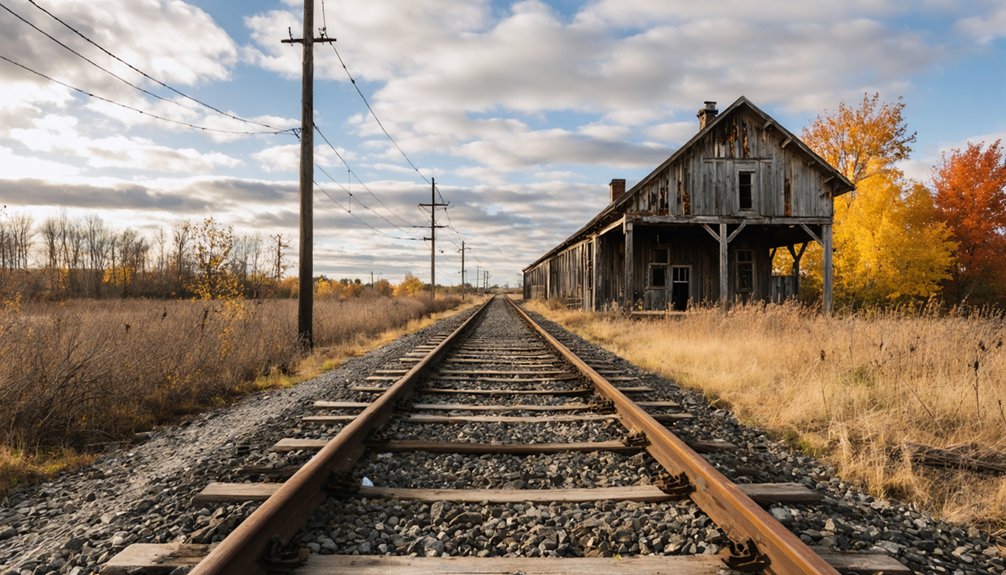
While many factors contributed to Toronto, Indiana’s rise and fall, the railroad’s influence towers above them all, shaping the town’s destiny with steel rails and wooden ties.
You can still trace the ghost town dynamics in the weathered remnants of what was once a bustling rail hub, where the rhythmic sounds of steam engines once echoed through the valley.
The railroad brought Toronto life, connecting you to distant markets and bringing fresh opportunities with each passing train.
But when newer transportation methods emerged and rail companies consolidated their routes, Toronto’s lifeline began to fade.
The town’s deep dependence on the railroad proved to be both its greatest strength and ultimate weakness.
Today, you’ll find only silent rails and memories where Toronto’s dreams of prosperity once rode the iron horse.
The Rise of Dana and Toronto’s Decline
The emergence of Dana in 1874 marked the beginning of Toronto’s end. When Charles Dana’s railroad bypassed Toronto, you could’ve watched the town’s significance drain away like sand through an hourglass.
The once-vibrant community organization that had built the Old Bono Methodist Church couldn’t compete with the allure of economic opportunities in Dana.
- Businesses packed up and moved to Dana’s bustling railroad hub
- Farmers found better markets for their crops in the new town
- Toronto’s residents gradually drifted toward Dana’s promise
- Church attendance dwindled as families relocated
- The once-busy streets grew silent and empty
You’d have felt the shift in energy as Dana’s population swelled while Toronto’s declined, not from any disaster or industry collapse, but simply because the future rolled through Dana on steel rails.
Lost Buildings and Forgotten Streets

Standing amid Toronto’s crumbling ruins today, you’d hardly recognize the once-bustling streets where merchants and townspeople conducted their daily business.
Nature has reclaimed what was once a vibrant network of roads and buildings, with trees and undergrowth obscuring the urban decay that tells Toronto’s story.
You’ll find scattered architectural remnants – partial walls of Greek Revival homes, crumbling chimney stacks, and foundation stones – peeking through the overgrowth.
The general stores, saloons, and hotels that once lined these streets have vanished, leaving only their ghostly footprints in the soil.
If you look carefully near the Grand River, you might spot traces of the old locks and bridges that once made Toronto a promising riverside town, now silent witnesses to time’s relentless march.
Local Business and Trade History
You can trace Toronto’s early business activity to its bustling sawmill and trading post, where farmers and merchants would gather to exchange their goods along the dusty main street.
The arrival of the railroad in nearby Michigan City shifted trade patterns away from Toronto’s commercial district, leaving local shopkeepers struggling to maintain their once-prosperous ventures.
When you walk those forgotten streets today, you’d never guess that horse-drawn wagons once lined up outside general stores and grain merchants to conduct the day’s business.
Early Commerce Activities
Once bustling with commercial activity, Toronto, Indiana’s early business landscape centered around waterway trade and local entrepreneurship.
You’d have found a vibrant scene of merchants and traders capitalizing on the region’s natural waterways to build their dreams of economic development. Early trade flowed through the town’s veins like the very waters that sustained it.
- Local entrepreneurs established thriving timber export businesses
- Family-owned operations dominated the commercial landscape
- Waterway transport served as the lifeblood of commerce
- Agricultural goods flowed freely through established trade routes
- Flour mills buzzed with constant activity
The spirit of free enterprise drew ambitious souls who saw opportunity in every passing boat and every acre of fertile soil.
Local merchants crafted their own destiny, transforming this frontier outpost into a showcase of commercial ingenuity and determination.
Railroad Impact on Trade
Steel rails sliced through Toronto’s landscape in the late 1800s, forever transforming the town’s commercial destiny. As you’d walk past the bustling rail depots, you’d witness farmers hauling their corn and wheat to newly built grain elevators, while merchants enthusiastically awaited shipments from Chicago’s burgeoning markets.
The rail trade breathed new life into local businesses, freeing them from seasonal river schedules. You’d have marveled at the economic transformation unfolding before your eyes – dairy farms expanding their reach, lumber mills shipping timber year-round, and store shelves stocked with goods from distant cities.
The Chicago, Lake Shore & South Bend Railway became Toronto’s lifeline to prosperity, though this golden age wouldn’t last. As automobiles gained popularity, the town’s rail-dependent economy began its slow decline into obscurity.
Notable Residents and Community Leaders
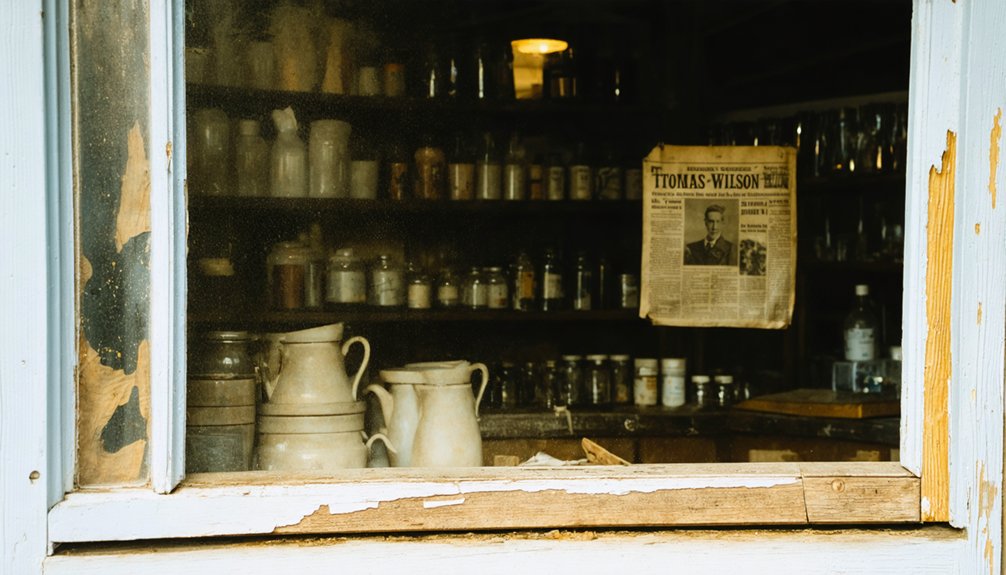
The towering presence of David Thompson loomed large over Indiana’s early development, with his ambitious vision and deep pockets helping transform the settlement into Haldimand County’s largest industrial town.
Through the halls of his grand Ruthven Park mansion, you’d have witnessed the community dynamics that shaped this bustling frontier town.
Notable figures who shaped Indiana’s destiny include:
- Thompson, whose Grand River Navigation Company became the town’s lifeblood
- Thomas Lester, whose lumber empire provided essential employment
- Religious leaders who ministered to two thriving churches
- The influential families whose names now rest in the Catholic cemetery
- Local business elites who helped govern daily affairs
While many residents’ stories have faded into history, the Thompson papers and archaeological findings continue revealing glimpses of these pioneering spirits who built Indiana from the ground up.
Legacy in Vermillion County
While Indiana’s pioneering spirits left their mark through Thompson’s grand vision, another Toronto settlement carved its own story into Vermillion County’s landscape.
You’ll find Toronto’s history echoing through the remnants of buildings that still stand along State Road 71, silent witnesses to the town’s rise and fall. When the railroad chose Dana over Toronto, you could say it marked the beginning of the end.
Yet Toronto’s cultural significance lives on in Vermillion County’s collective memory, intertwined with the region’s rich Native American heritage and agricultural roots.
You can trace the town’s legacy in the county’s unique “shoe string” geography and the economic shifts that shaped local communities.
Though Toronto’s streets are quiet now, its story remains a reflection of how railway decisions and changing times can reshape pioneer dreams.
Preserving Toronto’s Memory
Determined to preserve Toronto’s fading legacy, local preservation groups like Indiana Landmarks and Decay Devils have stepped forward with ambitious restoration plans.
Through memory engagement initiatives and heritage preservation efforts, you’ll find dedicated volunteers working tirelessly to keep Toronto’s story alive.
- Community cleanup projects breathe new life into forgotten structures
- Local history enthusiasts contribute photographs and oral histories to digital archives
- Art exhibitions and cultural events transform restored spaces into vibrant gathering spots
- Museum collections safeguard precious artifacts and documents
- Preservation specialists assess and repair historic buildings
You can experience Toronto’s rich heritage through these preservation efforts, joining forces with passionate locals who understand that every abandoned building holds countless stories.
Together, we’re ensuring that this ghost town’s spirit lives on through creative restoration and community involvement.
Frequently Asked Questions
What Native Tribes Originally Inhabited the Land Where Toronto Was Established?
You’ll find the Miami and Potawatomi tribes were the main Native tribes of historical significance in this area, though specific records don’t definitively document which tribes called Toronto’s exact location home.
Were There Any Significant Crimes or Murders Recorded in Toronto?
Precious past papers and present proof show no recorded crime history or murder incidents in this location. You won’t find factual evidence of significant criminal activity through historical documentation.
What Happened to the Cemetery Plots From Toronto’s Existence?
You’ll find the original Catholic cemetery still preserved at Ruthven Park today, where burial practices of the past remain visible through archaeological investigations, marking final resting places of Indiana’s early settlers.
Did Any Natural Disasters Contribute to Toronto’s Eventual Abandonment?
Ever wonder what forces of nature sealed Toronto’s fate? You’ll find no evidence of natural disasters or environmental factors contributing to its abandonment – the town’s decline came purely from economic and railroad-related decisions.
What Was the Peak Population of Toronto Before Its Decline?
You won’t find exact numbers for this ghost town’s peak population in historical records. Though the post office operated from 1838-1912, suggesting several hundred residents before its population decline began.
References
- https://www.islands.com/1754423/city-west-ghost-town-abandoned-buildings-once-dreamy-town-indiana-coastal-eerie-dune-beach/
- https://www.heraldtimesonline.com/story/lifestyle/home-garden/2020/05/01/ghost-towns-in-ohio-and-indiana/43807535/
- https://www.youtube.com/watch?v=6G0QCiwN5Ww&vl=en-US
- https://www.youtube.com/watch?v=xH5bPsKIGnM
- https://www.geotab.com/press-release/american-ghost-towns/
- https://ghostwalks.com/articles/old-squires-ghost-ruthven-cayuga
- https://en.wikipedia.org/wiki/List_of_ghost_towns_in_Indiana
- https://en.wikipedia.org/wiki/List_of_North_American_settlements_by_year_of_foundation
- https://www.youtube.com/watch?v=X6kmlnj7oYs
- https://www.historymuseumsb.org/early-history-of-indiana-to-1779/
